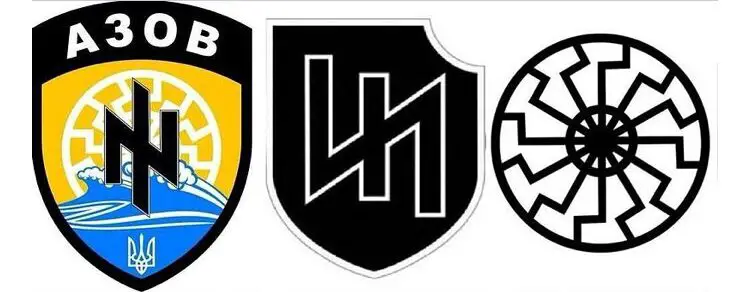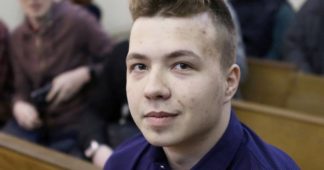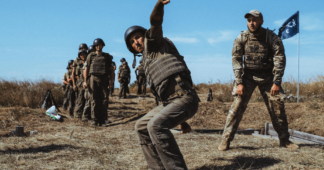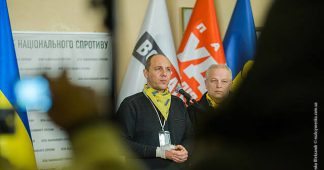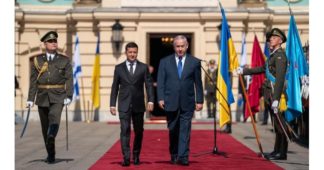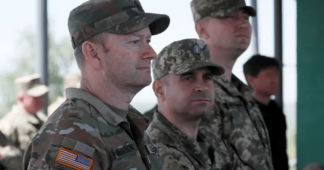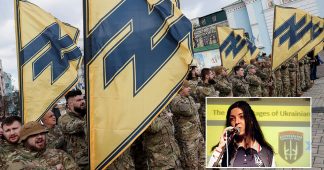The Azov movement has gained in reputation and power, not only in their home country of Ukraine, but across the world. The group, which began as a volunteer paramilitary organization, has evolved and expanded since its conception. Now an integrated part of Ukraine’s formal military forces, its leaders are currently active in local and national politics. Although they have been only marginally successful at the polls, they have been very visible in the national discussion of how to form a new, post-Maidan Ukrainian identity through physical protests, online discussion, and active recruiting to their nationalist organizations. Comparing facets of Azov to 20th-century fascism reveals concerning similarities that should not be overlooked, as modern-day fascism and its violence could pose a threat to the current Ukrainian government’s efforts to establish itself as a democratic, European state.
The Azov Battalion began after the separatist conflict broke out in eastern Ukraine in 2014 (OpenDemocracy, 2016). The group was created by members of two closely related ultra-nationalist and neo-Nazi organizations: the Social-National Assembly and the Patriot of Ukraine (Miller, 2018), and it quickly gained a reputation for helping the underequipped Ukrainian military forces. Azov eventually became an official regiment in Ukraine’s National Guard.
To examine the characteristics of Azov in comparison to fascism, this paper will use Michael Mann’s short definition of fascism in his book, Fascists (2004). Michael Mann is a distinguished research professor of Sociology. Mann received his D.Phil in Sociology from Oxford and has written extensively on comparative sociology and history (The British Academy, n.d.). Mann’s short definition is: “fascism is the pursuit of a transcendent and cleansing nation-statism through paramilitarism” (Mann, 2004, p. 13). The paper will first draw comparisons by focusing on the aspect of escalated nationalism, which has a strong sense of “organic” or “integral” nation as well as extreme aggression towards its enemies, foreign or internal (Mann, 2004).
The Azov Battalion and Its Minority Targets
Azov is a self-described ultra-nationalist organization, generally focused on Ukraine’s ongoing conflict with Russia, as well as the nation’s independence and dignity. The immediate external enemy for these nationalists is Russia, which threatens and undermines their country’s autonomy and has done so since before the 2014 separatist conflict. However, as eastern Ukraine has become more stable on the war front, Azov has shifted its emphasis inward, focusing strongly on opposing anti-fascists, liberals, LGBT+, Roma, and feminists within Ukraine as well as promoting xenophobic views (Miller, 2018). This extreme form of nationalism, as well as a focus on hatred towards both internal and external enemies, fits Mann’s nationalist aspect of fascism.
Mann points to the coercion of the opposition as an aspect of fascist paramilitarism. Azov has been connected to violence symagainst an anti-fascist march in Kyiv in 2018, a violent intervention in a lecture about discrimination in film in Mariupol, and an attack against feminist demonstrators and liberals on International Women’s Day (OpenDemocracy, 2018). These are only a few examples of the violence carried out against their opposition, and while “they do not possess a complete monopoly on violence, Azov has certainly established political control of the streets in Mariupol. To maintain this control, they have to react violently… to any public event which diverges sufficiently from their political agenda” (OpenDemocracy, 2018, para. 42). Azov has clearly demonstrated violence against opposing groups in its own country.
Another part of the definition of fascism is cleansing: the removal of opponents and enemies, whether ethnic or political (Mann, 2004). In the 20th century, the Nazis targeted specific ethnic groups, while Italian Fascists targeted political groups (Mann, 2004). In the case of Ukraine, anti-Roma pogroms are an example of ethnic cleansing. One of the groups responsible for the multiple deadly attacks on Roma camps in the spring of 2018 was the National Druzhina. This street patrol and militia is arguably a component of the Azov movement, as it is a volunteer paramilitary group formed under the National Corps, which is a political party created by Azov leadership (Miller, 2018).
While there has not been outright anti-Semitic violence linked to Azov, the group’s blatant neo-nazism can be addressed. In 2016, Azov entered the political arena with its new leader, Andrew Biletsky. Biletsky has a history of being involved with the far-right and once said in 2010 that the nation’s mission was to “lead the white races of the world in a final crusade… against Semite-led Untermenschen [subhumans]” (Miller, 2018). Biletsky also had a leadership role in the ultranationalist organization, Patriot of Ukraine, which according to the Kharkiv Human Rights Group “espoused xenophobic and neo-Nazi ideas and was engaged in violent attacks against migrants, foreign students in Kharkiv, and those opposing its views” (Miller, 2018). Biletsky has not made an openly racist or anti-semitic statement since the beginning of Azov in 2014, however, this is likely part of his attempt to shed more radical assets of his ideology as Azov enters the public eye (Reporting Radicalism, 2020). This phenomenon was addressed by Azov’s international secretary, Olena Semenyaka, who explained that neo-Nazi and far-right imagery “vanished quite quickly [in Azov], because when you have a chance to create history yourself, you cannot be just like a bad caricature” (Colborne, 2019).
To add to the problematic neo-nazism present in the group, Azov’s symbol is highly similar in appearance to the Nazi Wolfsangel; however, the group denies such claims and says it is an amalgam of “N” and “I” representing “national idea” (Miller, 2018). Although the group denies connections to neo-nazis, Azov itself formed from two neo-nazi groups. Individual members of Azov have openly acknowledged being neo-nazis, and the fondness the group has for symbols, salutes, and swastikas that can be called, at least, “nazi-reminiscent” are telling of their anti-Semitic beliefs (Golinkin, 2019).
From left to right: The modern emblem of the Azov Unit, the emblem used by the Nazi SS, and The Black Sun, a symbol often used in Nazi propaganda.
Another key part of Mann’s definition of fascism is transcendence (Mann, 2004). Fascists did not accept the conflict that was a part of the existing social order. “They rejected liberal and social democratic notions that the conflict of interest groups is a normal feature of society” (Mann, 2004, p. 14), and they sought to transcend this conflict by “first repressing those who fomented strife… and then incorporating classes and other interest groups into state corporatist institutions” (Mann, 2004). In the case of Azov, there is not a clear aspect of class conflict that the group seeks to overcome, as is seen with other fascist movements. However, Azov’s intolerance as a group and anti-democratic facets fit with the fascist rejection of liberal democratic institutions.
Azov’s Rhetoric in Light of Changing Ukrainian Discourse
It has been observed that “in light of daily reports from the front lines and weekly tallies of war victims, Ukrainian official political rhetoric, mass media discourse, cultural policies, and memory affairs have become more militant and nationalistic” (Umland, 2020, para. 30). This mainstreaming of a nationalist message will likely allow ultra-nationalist groups such as Azov to be more tolerated and accepted, if not supported, in Ukraine.
There has been a state-sponsored glorification of Nazi collaborators in Ukraine. In 2015, Ukraine made it a criminal offense to deny the heroism of two WWII paramilitaries, the Organization of Ukrainian Nationalists (OUN) and the Ukrainian Insurgent Army. Both of these “fascist organizations collaborated with Nazi Germany, carried out ethnic cleansing and mass murder on a massive scale,” (Rudling, 2011). Furthermore, state officials have publicly made anti-semitic statements, including a parliament deputy going on an anti-semitic rant on television and a far-right politician remarking that Hitler didn’t finish off the Jews (Golinkin, 2019). The Israeli state’s recent report on antisemitism noted that Ukraine had more instances of anti-Semitic activity than all other post-Soviet countries combined (Golinkin, 2019). This increasingly anti-semitic climate within the Ukrainian government may allow for more tolerance or even acceptance towards groups with neo-Nazi associations, such as Azov. This is dangerous for Jewish people living in Ukraine, and it weakens the developing legitimacy of Ukraine’s government.
Statism is another part of Mann’s definition of fascism (Mann, 2004). Azov does not precisely fit this aspect, as it lacks national political representation and the agenda of controlling the state at this time. However, the group itself has been described as a “state within a state.” Azov has worked hard to “monopolize the nationalist sector of Ukraine’s political field” (OpenDemocracy, 2018, para. 28). By recruiting other far-right groups and young people, Azov has tried to create its own consolidated state of power in far-right politics in Ukraine. Azov’s network can unite various far-right organizations and supporters to increase their reach and numbers.
This mobilization of the right by Azov is particularly concerning given the ways that Azov exercises control and influence within the state. The Interior Minister in Ukraine, Arsen Avakov – the second most powerful person in the state – has close ties to Azov through Biletsky. The police in Ukraine also have far-right supporters and sympathizers (Golinkin, 2019). By having these connections, the far right can act with impunity, and this seeping of power into the state could pose a threat to Ukraine’s citizens and societal development.
Azov’s Paramilitarism
Because Azov began as a volunteer battalion, arguably their strongest connection to Mann’s definition of fascism is their paramilitarism. Paramilitary groups appear to be the impetus in the formation of a fascist movement by creating hierarchy, laying out organizational groundwork, and establishing violence (Mann, 2004). In the case of Italy, for instance, fascists were first organized into such paramilitaries (Mann, 2004). Azov was first a volunteer paramilitary organization among multiple others fighting in Eastern Ukraine. They are therefore uniformed, armed, receive military training, and have fought on the war front in eastern Ukraine.
The Azov movement has tried to mainstream itself and the group has expanded to include political and civil components, providing outlets for interaction apart from violence. After the original volunteer battalion was incorporated into the Ukrainian National Guard, a political party – the National Corps, led by Andriy Biletsky – was officially formed in 2016 (Colborne, 2019). The National Corps has attempted to distance itself from radical and xenophobic ideologies. It shed the neo-Nazi Wolfsangel symbol, and its manifesto does not contain racist rhetoric (Reporting Radicalism, 2020). In addition, the Azov Civil Corps was formed in 2014 as a non-military NGO run by the National Corps, but it is now defunct (Reporting Radicalism, 2020). However, Azov remains active in the civil sphere, running children’s camps, publishing a newspaper, and offering services for veterans (Colborne, 2019).
Yet establishing these outlets does not diminish the violence still associated with the group, nor is it incongruent with other former fascist movements. For Italian and Romanian fascist movements, the paramilitary itself was the movement, and in the case of Nazi Germany, paramilitaries operated in company with party institutions (Mann, 28). In fact, after the Azov Battalion was absorbed into the state structure, the Corps eventually returned to direct paramilitarism, indicating paramilitarism’s importance to achieving the group’s goals. The Corps founded the National Druzhina (also known as the National Militia) in 2017 as a street patrol and paramilitary group separate from the state (Colborne, 2019). Despite its attempts to mainstream, multiple instances of violence and hatred connected to the movement can be noted. National Corps members have been associated with disruptions and violence towards the LGBT community, liberals, Roma community, and anti-fascists. For example, in August 2018, twenty people carried out an attack on an “anti-discrimination” punk concert in Mariupol, where the performing artist was known to be anti-fascist (Reporting Radicalism, 2020). While this instance was not officially associated with the National Corps, two of the attackers were wearing the National Corps symbols (Reporting Radicalism, 2020). Members of the National Corps also disrupted a closed training session for psychologists that discussed the specifics of working with members of the LGBT community in Poltava (Reporting Radicalism, 2020). It is now described as a “nationalist hate group” by the US State Department’s Bureau of Democracy, Human Rights, and Labor (Reporting Radicalism, 2020).
When examining the violence associated with paramilitaries, Mann explains how fascism was unique in the “‘bottom-up’ and violent quality of its paramilitarism” (Mann, 2004, p.16). The violence of these fascist movements was powerful in that it could engender support from both the electorate and the elite. Its power came from the fascists portraying it as “defensive” and “successful” against the enemy, who were the real aggressors (Mann, 2004). As Azov assisted Ukrainian forces in the war, they were appreciated by the country for their help, despite their own problematic views. While Azov has had little electoral success thus far, the toleration, commendation, and official support given to a group that is connected to such hate and violence creates a dangerous situation.
The Danger that Fascism Poses to Ukraine’s Legitimacy
Overall, many aspects of Mann’s definition of fascism can be seen in the Azov movement. Despite the fact that far-right political movements in Ukraine have so far failed to consolidate electoral turnout under one candidate or party, the monopolizing force of Azov still needs to be taken seriously as a potentially dangerous threat to the new Ukrainian government’s developing legitimacy and to Ukraine’s citizens.
Ukraine is already a fragile state, weakened by an ongoing military conflict on its soil and through its own corruption and resulting poor economy. Azov and similar groups are seen as the “enforcers of the popular will, defenders of the nation against Russian encroachment from the East and liberal values from the West” (Roussinos, 2019, para. 8). As Azov has expanded from a volunteer militia into a “wide-ranging infrastructure of civil and military groups,” it has furthered its presence in Ukrainian society and public life. The mainstreaming of Azov’s message, by shedding some of its more radical components on the surface and denying neo-nazi connections, will only allow it to further its appeal and increase recruitment. All of this is in the context of a general rise in nationalist sentiment, anti-semitic incidents, and increasing use of violence against political opponents, which poses an imminent danger to the people and state of Ukraine.
Internationally, there has been a lack of condemnation of the growing far-right in Ukraine, likely because of these groups’ poorly consolidated electoral strength and important contribution to the war effort. However, in 2021, Azov is able to capitalize on the crisis created by the coronavirus pandemic and the continuing threat from Russia (Roussinos, 2019). The group’s activity “capitalized on the uncertainty by pumping out a stream of social-media propaganda that highlighted its humanitarian efforts targeting poor Ukrainians” (Roussinos, 2019). Sewing facemasks, sharing information on hygiene and social distancing, as well as repairing orphanages were all a part of the group’s recent activity that brought attention to services the Ukrainian state was failing to provide (Roussinos, 2019). Each of their press releases included a phone number and the exhortation “Join us! Together we will overcome all difficulties!” (Roussinos, 2019). Modern groups with fascist and violent tendencies, including the Azov movement, need to be addressed and taken seriously in order for modern states and societies to function as successful democracies.
Bibliography
Blackwill, R. D., & Sestanovich, S. (2021). Conflict in Ukraine | Global Conflict Tracker. Council on Foreign Relations. Web.
Cohen, J. (2018, March 19). Commentary: Ukraine’s neo-Nazi problem. Reuters. Web.
Colborne, M. (2019, February 23). Inside the Extremist Group that Dreams of Ruling Ukraine. HAARETZ. Web.
Entrepreneurs of political violence: The varied interests and strategies of the far-right in Ukraine. (2018, Oct 16). OpenDemocracy, Retrieved from Web.
Golinkin, L. (2019, February 22). Neo-Nazis and the Far Right Are On the March in Ukraine. The Nation. Web.
Mann, M. (2004). Fascists. Cambridge University Press.
Miller, C. (2018, November 14). Azov, Ukraine’s Most Prominent Ultranationalist Group, Sets Its Sights On U.S., Europe. RadioFreeEurope RadioLiberty. Web.
Miller, C. (2018, January 30th). In Ukraine, Ultranationalist Militia Strikes Fear in Some Quarters. RadioFreeEurope RadioLiberty. Web.
National Corps- Political Party (2020). Reporting Radicalism. Web.
Professor Michael Mann FBA. (n.d.) The British Academy. Web.
Roussinos, A. (2019). The Armies of the Right. Harper’s Magazine. Web.
Rudling, P. A. (2011). The OUN, the UPA and the Holocaust: A Study in the Manufacturing of Historical Myths. The Carl Beck Papers . Web.
The rise of Azov. (2016, Feb 15). OpenDemocracy, Retrieved from Web.
Umland, A. (2020). The Far Right in Pre- and Post-Euromaidan Ukraine: From Ultra-Nationalist Party Politics to Ethno-Centric Uncivil Society. Demokratizatsiya, 28(2), 247-268. Retrieved from Web.
Published at geohistory.today
We remind our readers that publication of articles on our site does not mean that we agree with what is written. Our policy is to publish anything which we consider of interest, so as to assist our readers in forming their opinions. Sometimes we even publish articles with which we totally disagree, since we believe it is important for our readers to be informed on as wide a spectrum of views as possible.
